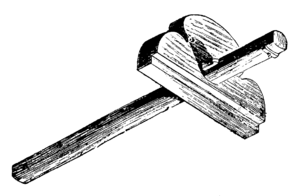Marking and Scribing.—The carpenter's lead pencil is of a flat, oval section, sharpened to a chisel edge, which has a greater body of lead than a point, and lasts a reasonable time before requiring to be re-sharpened. The marking awl and the striking knife, shown in Fig. 2 as a combined tool, is used by joiners principally for scribing, or cutting-in, the shoulders of framing, etc. Greater accuracy can be attained and a sharper arris is left when sawing than when working to a pencil line.
Straight-edge.—Mechanics in the building trades use a straight-edge, usually made to the shape shown by Fig. 3, and not larger than 15 ft. long, 6 in. wide, and 1¼ in. thick, made from a pine board cut from a straight-grown tree. All straight-edges should be tested occasionally.
Squares and Bevels.—These are used for setting out and testing work. The joiner's steel square is a mere right angle of steel, sometimes nickel-plated, graduated in inches, ¼ in. and in., or otherwise as required. The try square (Fig. 4) has a rosewood or ebony stock. The tool shown by Fig. 5 is also of use in setting out and testing mitres, but the proper mitre square is shown by Fig. 6. Try squares are also made with iron frames which are channelled and perforated to reduce weight. Adjustable squares with graduated blades are useful in putting fittings on doors and windows. By means of the sliding bevel (Fig. 7) angles are set off in duplicate; the set screw secures the blade at any desired angle with the stock. A crenellated square has a blade which is notched at every principal graduation, and is used chiefly for setting out mortises and tenons.
Marking Work for Sawing.—The chalk line is used for long pieces of timber, the pencil and rule for ordinary applications, and the scribe for particular work. The "chalk line" is a piece of fine cord rubbed with chalk or black pigment, and strained taut. To mark the work the chalk line is lifted vertically and near the centre, and when released makes a fine and perfectly straight line upon the work. Coloured chalks and pigments are also used.
Marking and Cutting Gauges.—Ordinarily the carpenter draws a line close to and parallel to the edge of a board by means of a rule held in one hand, with the forefinger against the edge of the work and the pencil held close against the end of the rule; but the marking gauge (Fig. 8) gives more accurate results. The gauge may have a pencil point instead of the steel point shown. Developments are the mortise gauge (Fig. 9) and the cutting gauge (Fig. 10), having either a square or oval sliding stock or head. The panel gauge (Fig. 11) is used to mark a line parallel to the true edge of a panel or of any piece of wood too wide for the ordinary gauge to take in.
Compasses, Dividers, and Callipers.—Ordinary wing compasses (Fig. 12) are




